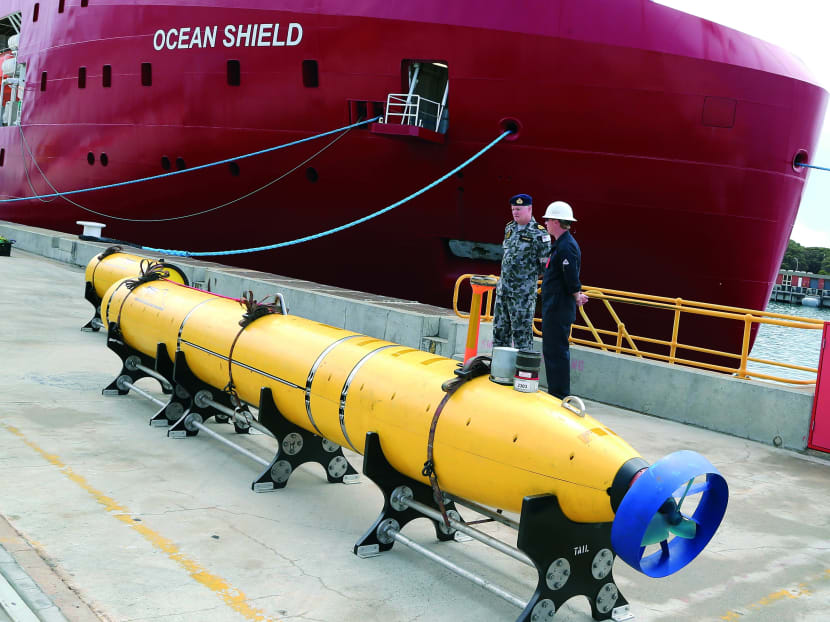Robot submarines could be the tool to unlock MH370 mystery
NEW YORK — Three kilometres down or more and darker than night, the ocean becomes a particularly challenging place for human searchers.

An autonomous underwater
vehicle at the HMAS Stirling naval base in Perth, Australia, has been fitted to the Australian ship Ocean Shield to help in the search for Flight MH370. Photo: AP
NEW YORK — Three kilometres down or more and darker than night, the ocean becomes a particularly challenging place for human searchers.
If the missing Malaysian airliner rests somewhere in the depths of the Indian Ocean, investigators will likely need to entrust the hunt, at least partly, to robot submarines and the scientists who deploy them to scan remote swathes of the seafloor.
Such unmanned submarines, called autonomous underwater vehicles or AUVs, played a critical role in locating the wreckage of a lost Air France jet in 2011, two years after it crashed in the middle of the south Atlantic. The find enabled searchers to recover the black boxes that revealed the malfunctions behind the tragedy.
That search keyed off critical information: The search area for the Air France jet was much smaller than that for Malaysia Airlines Flight MH370 and the first pieces of wreckage were recovered within days of the crash.
Even then, it required two years and four deep-water search missions before a team from the Woods Hole Oceanographic Institution (WHOI), using an AUV equipped with side-scan sonar, located the jet about 3,900m under water.
“Air France 447 is a bit different from Malaysia Air 370 in that we had a few more clues to work with,” said Dr Dave Gallo, who led the search team from WHOI, located on Massachusetts’ Cape Cod.
The independent research institution has offered its services to MH370 investigators, but has not yet been asked to join the search effort.
If the investigators can zero in on what they think is the plane’s last known location, they will probably turn to AUVs to begin the methodical task of tracking back and forth across miles of ocean floor in search of anomalies that might be wreckage.
The unmanned submarines used by the WHOI team were developed as tools to research and monitor relatively shallow coastal waters, measuring variables such as salinity and temperature over wide areas for hours on end.
However, AUVs are increasingly being harnessed to perform some of the most demanding underwater jobs.
The United States Navy uses them to search for underwater mines because they can stay below the surface of even very cold water much longer than any diver, without the worry of exposing a human to danger. Energy firms employ unmanned subs to survey the floor at underwater drill sites.
The area off western Australia where search planes and aircraft are looking for the Malaysian jet slopes from about 800m to depths of 3,000m. However, part of the zone drops into the narrow Diamantina Trench, with depths of about 5,800m.
“Let’s hope the plane has not landed over this escarpment. It’s a long way to the bottom,” said Dr Robin Beaman, a marine geologist from Australia’s James Cook University.
The US Navy last week sent a Bluefin-21 autonomous submarine to Australia to prepare for an eventual deep water search. That submarine can dive to about 4,500m. The largest unmanned submarines used by WHOI researchers are built to reach depths of about 6,000m.
AUVs can scan a larger area more quickly, without being affected by conditions on the surface. However, they must be brought back to the surface to be recharged and for researchers to download and analyse their data.
Even so, they are much better suited to the job of a deep-water search than any manned submarine, whose descents are limited by air, light and power, as well as safety concerns, said Professor William Sager, a professor of marine geophysics at the University of Houston.
Prof Sager recalled that in 2000, when he climbed aboard a submarine and ventured 1,700m down to the bottom of the Gulf of Mexico, all those factors limited time on the sea floor to just four hours, moving at a crawl. A researcher looking out a porthole into even the clearest water with a very bright light cannot see beyond 30m, he said.
Unmanned submarines are far more flexible. When WHOI engineers built their first REMUS 6000 submarine a little more than a decade ago, they tested it off the Bahamas by driving it down a trench the scale of the Grand Canyon, said Mr Chris von Alt, who led the team that developed the craft and then co-founded Hydroid, the Massachusetts manufacturer of the submarines.
The REMUS submarine — nearly 4m long, weighs 860 kg and is mustard yellow — is equipped with sonar that can be programmed to capture images of vast stretches of seafloor and the objects resting there. Powered by a lithium battery, the unmanned submarines can stay below the surface for 20 to 24 hours.
Scientists on the surface are now able to modify instructions to the submarine via an acoustic link that allows them to look at bits of data gathered by the vehicle, Mr von Alt said.
However, they do not know what the submarine has found until it surfaces and its data is downloaded to a computer.
The task requires patience and for researchers whose livelihoods are focused on ocean life, a willingness to harness their expertise in a grim, but necessary pursuit of answers.
“That’s why you do it,” Mr von Alt said. “One of (the reasons) is, ‘Why did it happen?’ But the other is to get closure for the families who have suffered through the tragedy.” AP





